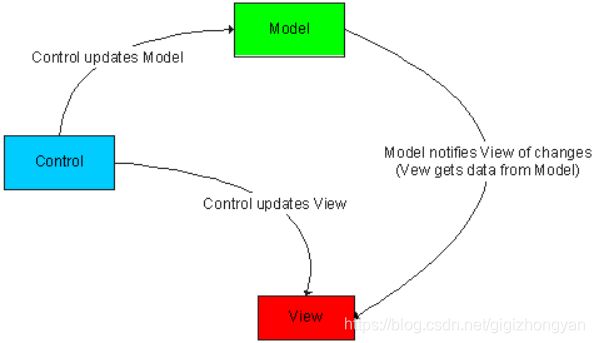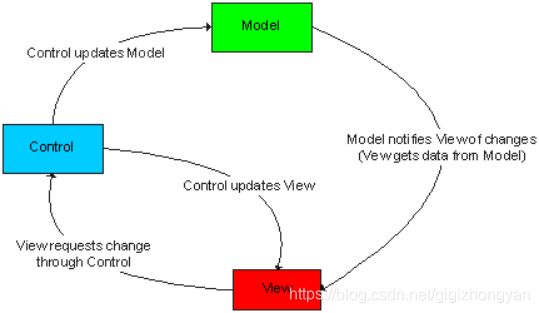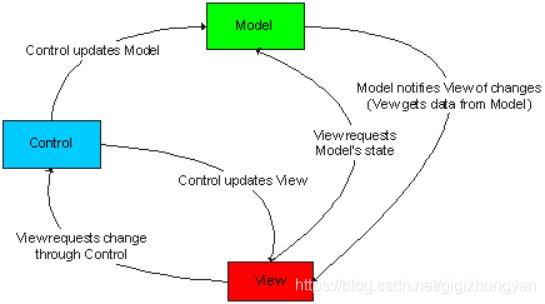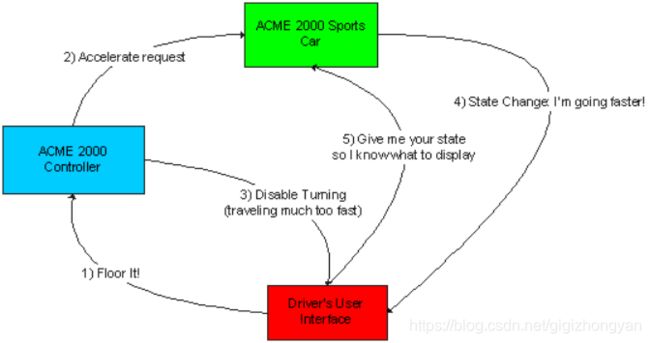用C#实现MVC+观察者模式(WINFORM)
用C#实现MVC(Model View Control)模式介绍
益处
下载案例:https://download.csdn.net/download/gigizhongyan/13011332
在我们的开发项目中使用MVC(Model-View-Control)模式的益处是,可以完全降低业务层和应用表示层的相互影响。此外,我们会有完全独立的对象来操作表示层。MVC在我们项目中提供的这种对象和层之间的独立,将使我们的维护变得更简单使我们的代码重用变得很容易(下面你将看到)。
作为一般的习惯,我们知道我们希望保持最低的对象间的依赖,这样变化能够很容易的得到满足,而且我们可以重复使用我们辛辛苦苦写的代码。为了达到这个目的我们将遵循一般的原则“对接口编成,而不是对类”来使用MVC模式。
我们的构架概要
好,现在我们知道我们要使用MVC,我们需要指出它的本质。通过我们的试验得出MVC的三个部分:Model,Control和View。在我们的系统中,Model就是我们的汽车,View就是我们的画面,Control将这两个部分联系起来。
![]() 正在上传…重新上传取消
正在上传…重新上传取消
为了改变Model(我们的ACME 2000 sports car),我们需要使用Control。我们的Control将会产生给Model(我们的ACME 2000 sports car)的请求,和更新View,View就是我们的画面(UI)。
这看起来很简单,但是这里产生了第一个要解决的问题:当终端用户想做一个对ACME 2000 sports car一个改变将会发生什么,比如说加速或是转向?他们将通过View(our windows form)用Control来提出一个变化的申请。
![]() 正在上传…重新上传取消
正在上传…重新上传取消
现在我们就剩下一个未解决问题了。如果View没有必要的信息来显示Model的状态怎么办?我们需要再在我们的图中加入一个箭头:View将能申请Model的状态以便得到它要显示的相关状态信息。
![]() 正在上传…重新上传取消
正在上传…重新上传取消
最后,我们的最终用户(司机)将会和我们的ACME Vehicle Control系统通过View来交互。如果他们想发出一个改变系统的申请,比如提高一点加速度,申请将会从View开始发出由Control处理。
Control将会向Model申请改变并将必要的变化反映在View上。比如,如果一个蛮横的司机对ACME 2000 Sports Car做了一个"floor it"申请,而现在行驶的太快不能转向,那么Control将会拒绝这个申请并在View中通知,这样就防止了在交通拥挤是发生悲惨的连环相撞。
Model (the ACME 2000 Sports Car) 将通知View 它的速度已经提高,而View也将做适当的更新。
综上,这就是我们将构建的概要:
![]() 正在上传…重新上传取消
正在上传…重新上传取消
首先,我们考虑一下基本的项目。我们需要一些东西来表示方向和转动请求。我们做了两个枚举类型:AbsoluteDirection 和 RelativeDirection
public enum AbsoluteDirection
{
North=0, East, South, West
}
public enum RelativeDirection
{
Right, Left, Back
}
下面来解决Control接口。我们知道Control需要将请求传递给Model,这些请求包括:Accelerate, Decelerate, 和 Turn。我们建立一个IVehicleControl接口,并加入适当的方法。
public interface IVehicleControl
{
void Accelerate(int paramAmount);
void Decelerate(int paramAmount);
void Turn(RelativeDirection paramDirection);
}
现在我们来整理Model接口。我们需要知道汽车的名字,速度,最大速度,最大倒退速度,最大转弯速度和方向。我们也需要加速,减速,转弯的函数。
public interface IVehicleModel
{
string Name{ get; set;}
int Speed{ get; set;}
int MaxSpeed{ get;}
int MaxTurnSpeed{ get;}
int MaxReverseSpeed { get;}
AbsoluteDirection Direction{get; set;}
void Turn(RelativeDirection paramDirection);
void Accelerate(int paramAmount);
void Decelerate(int paramAmount);
}
最后,我们来整理View接口。我们知道View需要暴露出Control的一些机能,比如允许或禁止加速,减速和转弯申请。
public interface IVehicleView
{
void DisableAcceleration();
void EnableAcceleration();
void DisableDeceleration();
void EnableDeceleration();
void DisableTurning();
void EnableTurning();
}
现在我们需要做一些微调使我们的这些接口能够互相作用。首先,任何一个Control都需要知道它的View和Model,所以在我们的IvehicleControl接口中加入两个函数:"SetModel" 和"SetView":
public interface IVehicleControl
{
void RequestAccelerate(int paramAmount);
void RequestDecelerate(int paramAmount);
void RequestTurn(RelativeDirection paramDirection);
void SetModel(IVehicleModel paramAuto);
void SetView(IVehicleView paramView);
}
下一个部分比较巧妙。我们希望View知道Model中的变化。为了达到这个目的,我们使用观察者模式。
为了实施观察者模式,我们需要将下面的函数加入到Model(被View观察):AddObserver, RemoveObserver, 和 NotifyObservers。
public interface IVehicleModel
{
string Name{ get; set;}
int Speed{ get; set;}
int MaxSpeed{ get;}
int MaxTurnSpeed{ get;}
int MaxReverseSpeed { get;}
AbsoluteDirection Direction{get; set;}
void Turn(RelativeDirection paramDirection);
void Accelerate(int paramAmount);
void Decelerate(int paramAmount);
void AddObserver(IVehicleView paramView);
void RemoveObserver(IVehicleView paramView);
void NotifyObservers();
}
并且将下面的函数加入到View(被Model观察)中。这样做的目的是Model会有一个View的引用。当Model发生变化时,将会调用NotifyObservers()方法,传入一个对其自身的引用并调用Update()通知View这个变化。
public class IVehicleView
{
void DisableAcceleration();
void EnableAcceleration();
void DisableDeceleration();
void EnableDeceleration();
void DisableTurning();
void EnableTurning();
void Update(IVehicleModel paramModel);
}
这样我们就将我们的接口联系起来了。在下面的代码中我们只需要引用我们这些接口,这样就保证了我们代码的低耦合。任何显示汽车状态的用户界面都需要实现IVehicleView,我们所有的ACME都需要实现IVehicleModel,并且我们需要为我们的ACME汽车制作Controls,这些Control将实现IVehicleControl接口。
我们知道所有的汽车都做相同的动作,所以我们接下来做一个基于“骨架”的共有的代码来处理这些操作。这是一个抽象类,因为我们不希望任何人在“骨架”上开车(抽象类是不能被实例化的)。我们称其为Automobile。我们将用一个ArrayList (from System.Collections)来保持跟踪所有感兴趣的Views(记住观察者模式了吗?)。我们也可以用老式的数组来记录对IVehicleView的引用,但是现在我们已经很累了想快点结束这篇文章。如果你感兴趣,看一下在观察者模式中AddObserver, RemoveObserver, 和NotifyObservers,这些函数是怎样和IVehicleView互相作用的。任何时间当有速度或方向变化时,Automobile通知所有的IVehicleViews。
public abstract class Automobile: IVehicleModel
{
"Declarations "#region "Declarations "
private ArrayList aList = new ArrayList();
private int mintSpeed = 0;
private int mintMaxSpeed = 0;
private int mintMaxTurnSpeed = 0;
private int mintMaxReverseSpeed = 0;
private AbsoluteDirection mDirection = AbsoluteDirection.North;
private string mstrName = "";
#endregion
"Constructor"#region "Constructor"
public Automobile(int paramMaxSpeed, int paramMaxTurnSpeed, int paramMaxReverseSpeed, string paramName)
{
this.mintMaxSpeed = paramMaxSpeed;
this.mintMaxTurnSpeed = paramMaxTurnSpeed;
this.mintMaxReverseSpeed = paramMaxReverseSpeed;
this.mstrName = paramName;
}
#endregion
"IVehicleModel Members"#region "IVehicleModel Members"
public void AddObserver(IVehicleView paramView)
{
aList.Add(paramView);
}
public void RemoveObserver(IVehicleView paramView)
{
aList.Remove(paramView);
}
public void NotifyObservers()
{
foreach(IVehicleView view in aList)
{
view.Update(this);
}
}
public string Name
{
get
{
return this.mstrName;
}
set
{
this.mstrName = value;
}
}
public int Speed
{
get
{
return this.mintSpeed;
}
}
public int MaxSpeed
{
get
{
return this.mintMaxSpeed;
}
}
public int MaxTurnSpeed
{
get
{
return this.mintMaxTurnSpeed;
}
}
public int MaxReverseSpeed
{
get
{
return this.mintMaxReverseSpeed;
}
}
public AbsoluteDirection Direction
{
get
{
return this.mDirection;
}
}
public void Turn(RelativeDirection paramDirection)
{
AbsoluteDirection newDirection;
switch(paramDirection)
{
case RelativeDirection.Right:
newDirection = (AbsoluteDirection)((int)(this.mDirection + 1) %4);
break;
case RelativeDirection.Left:
newDirection = (AbsoluteDirection)((int)(this.mDirection + 3) %4);
break;
case RelativeDirection.Back:
newDirection = (AbsoluteDirection)((int)(this.mDirection + 2) %4);
break;
default:
newDirection = AbsoluteDirection.North;
break;
}
this.mDirection = newDirection;
this.NotifyObservers();
}
public void Accelerate(int paramAmount)
{
this.mintSpeed += paramAmount;
if(mintSpeed >= this.mintMaxSpeed) mintSpeed = mintMaxSpeed;
this.NotifyObservers();
}
public void Decelerate(int paramAmount)
{
this.mintSpeed -= paramAmount;
if(mintSpeed <= this.mintMaxReverseSpeed) mintSpeed = mintMaxReverseSpeed;
this.NotifyObservers();
}
#endregion
}
最后但不是至少
现在我们的"ACME Framework"已经做好了,我们只需要设立有形的类和接口。首先让我们看看最后两个类:Control 和 Model...
这里我们有形的AutomobileControl实现IVehicleControl接口。我们的AutomobileControl也将设置View来依赖Model 的状态
注意,我们只是有对IVehicleModel的引用(而不是抽象类Automobile )和对IVehicleView的引用(而不是具体的View),这样保证对象间的低耦合。
public class AutomobileControl: IVehicleControl
{
private IVehicleModel Model;
private IVehicleView View;
public AutomobileControl(IVehicleModel paramModel, IVehicleView paramView)
{
this.Model = paramModel;
this.View = paramView;
}
public AutomobileControl()
{
}
IVehicleControl Members#region IVehicleControl Members
public void SetModel(IVehicleModel paramModel)
{
this.Model = paramModel;
}
public void SetView(IVehicleView paramView)
{
this.View = paramView;
}
public void RequestAccelerate(int paramAmount)
{
if(Model != null)
{
Model.Accelerate(paramAmount);
if(View != null) SetView();
}
}
public void RequestDecelerate(int paramAmount)
{
if(Model != null)
{
Model.Decelerate(paramAmount);
if(View != null) SetView();
}
}
public void RequestTurn(RelativeDirection paramDirection)
{
if(Model != null)
{
Model.Turn(paramDirection);
if(View != null) SetView();
}
}
#endregion
public void SetView()
{
if(Model.Speed >= Model.MaxSpeed)
{
View.DisableAcceleration();
View.EnableDeceleration();
}
else if(Model.Speed <= Model.MaxReverseSpeed)
{
View.DisableDeceleration();
View.EnableAcceleration();
}
else
{
View.EnableAcceleration();
View.EnableDeceleration();
}
if(Model.Speed >= Model.MaxTurnSpeed)
{
View.DisableTurning();
}
else
{
View.EnableTurning();
}
}
}
现在轮到我们的View了...
现在终于开始建立我们MVC最后一个部分了...View!
我们要建立一个AutoView来实现IVehicleView接口。这个AutoView将会有对Control和Model接口的引用。
public class AutoView : System.Windows.Forms.UserControl, IVehicleView
{
private IVehicleControl Control = new ACME.AutomobileControl();
private IVehicleModel Model = new ACME.ACME2000SportsCar("Speedy");
}
我们也需要将所有的东西包装在UserControl的构造函数中。
public AutoView()
{
// This call is required by the Windows.Forms Form Designer.
InitializeComponent();
WireUp(Control, Model);
}
public void WireUp(IVehicleControl paramControl, IVehicleModel paramModel)
{
// If we're switching Models, don't keep watching
// the old one!
if(Model != null)
{
Model.RemoveObserver(this);
}
Model = paramModel;
Control = paramControl;
Control.SetModel(Model);
Control.SetView(this);
Model.AddObserver(this);
}
private void btnAccelerate_Click(object sender, System.EventArgs e)
{
Control.RequestAccelerate(int.Parse(this.txtAmount.Text));
}
private void btnDecelerate_Click(object sender, System.EventArgs e)
{
Control.RequestDecelerate(int.Parse(this.txtAmount.Text));
}
private void btnLeft_Click(object sender, System.EventArgs e)
{
Control.RequestTurn(RelativeDirection.Left);
}
private void btnRight_Click(object sender, System.EventArgs e)
{
Control.RequestTurn(RelativeDirection.Right);
}
public void UpdateInterface(IVehicleModel auto)
{
this.label1.Text = auto.Name + " heading " + auto.Direction.ToString() + " at speed: " + auto.Speed.ToString();
this.pBar.Value = (auto.Speed>0)? auto.Speed*100/auto.MaxSpeed : auto.Speed*100/auto.MaxReverseSpeed;
}
public void DisableAcceleration()
{
this.btnAccelerate.Enabled = false;
}
public void EnableAcceleration()
{
this.btnAccelerate.Enabled = true;
}
public void DisableDeceleration()
{
this.btnDecelerate.Enabled = false;
}
public void EnableDeceleration()
{
this.btnDecelerate.Enabled = true;
}
public void DisableTurning()
{
this.btnRight.Enabled = this.btnLeft.Enabled = false;
}
public void EnableTurning()
{
this.btnRight.Enabled = this.btnLeft.Enabled = true;
}
public void Update(IVehicleModel paramModel)
{
this.UpdateInterface(paramModel);
}
幸运的是我们用的是MVC!我们需要做的所有工作就是建立一个新的ACMETruck类,包装一下,完事!
public class ACME2000Truck: Automobile
{
public ACME2000Truck(string paramName):base(80, 25, -12, paramName){}
public ACME2000Truck(string paramName, int paramMaxSpeed, int paramMaxTurnSpeed, int paramMaxReverseSpeed):
base(paramMaxSpeed, paramMaxTurnSpeed, paramMaxReverseSpeed, paramName){}
}
在AutoView中,我们只需要建立卡车包装一下!
private void btnBuildNew_Click(object sender, System.EventArgs e)
{
this.autoView1.WireUp(new ACME.AutomobileControl(), new ACME.ACME2000Truck(this.txtName.Text));
}
如果我们想要一个新Control只允许我们来每次加速或减速最大5mph,小意思!做一个SlowPokeControl(和我们的AutoControl相同,但是在申请加速度中做了限制)。
public void RequestAccelerate(int paramAmount)
{
if(Model != null)
{
int amount = paramAmount;
if(amount > 5) amount = 5;
Model.Accelerate(amount);
if(View != null) SetView();
}
}
public void RequestDecelerate(int paramAmount)
{
if(Model != null)
{
int amount = paramAmount;
if(amount > 5) amount = 5;
Model.Accelerate(amount);
Model.Decelerate(amount);
if(View != null) SetView();
}
}
如果我们想让我们的ACME2000 Truck变得迟钝,只需要在AutoView中包装。
private void btnBuildNew_Click(object sender, System.EventArgs e)
{
this.autoView1.WireUp(new ACME.SlowPokeControl(), new ACME.ACME2000Truck(this.txtName.Text));
}
最后,如果我们需要一个在web上的接口,我们要做的所有工作就是建立一个Web项目在UserControl中实现IVehicleView接口。
结论
正如你所看到的,使用MVC来构建代码控制接口耦合性很低,很容易适应需求的改变。它也能使变化的影响减小,而且你可以在任何地方重用你的虚函数和接口。有很多时候我们可以在我们的项目中实现伸缩性,特别是在那些需求变化的时候,但是这需要下次再说了。




